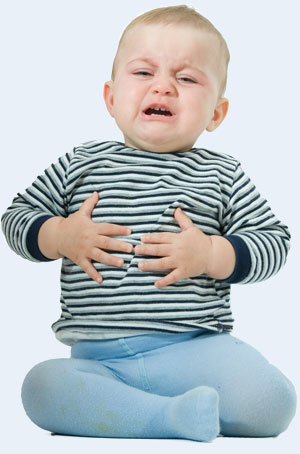. Duration of the pain: Most simple causes of abdominal pain do not last long. Most of us have experienced gas pains or the stomach/gut flu, and recall that the pain was usually gone within 24 hours. Any abdominal pain that continues longer than 24 hours should be evaluated by a physician.
. Location of the pain: Most simple pains are located in the center of the abdomen. The child will rub around his or her belly button. Pain felt in other areas is more concerning. This is especially true of pain located low and down on the right side of the abdomen. Pain in that area should be considered as appendicitis until proven otherwise.
. Appearance of the child: As a general rule, if the child looks very ill in addition to being in pain, medical help should be sought. Often, the caregiver "just knows" the child is very sick. When abdominal pain occurs, key things to look for include pale appearance, sweating, sleepiness or listlessness. It is most concerning when a child cannot be distracted from the pain with play, or refuses to drink or eat for several hours.
. Rash: Certain serious causes of abdominal pain also occur with a new rash. The combination of skin rash with abdominal pain is a reason to contact your doctor. Continue Reading. Vomiting: Children vomit quite frequently with abdominal pain, but vomiting does not always indicate a serious problem. However, as with the duration of the pain, most simple causes of vomiting go away very quickly. The rule again is that vomiting for longer than 24 hours is a legitimate reason to call the physician.
. Nature of the vomiting: In infants and very young children, vomiting that is green or yellow is a reason to call the doctor. At any age, vomiting that appears to contain blood or darker material is a reason to seek emergency care.
. Diarrhea: Diarrhea is also common with abdominal pain and usually indicates that a virus is the cause. This can continue for several days but usually only lasts less than 72 hours (three days). Any blood in the stool is a reason to seek medical care.
. Fever: The presence of fever does not always indicate a serious problem. Indeed, a normal temperature can be seen with the more serious causes of abdominal pain.
. Groin pain: One serious problem that a boy may describe as abdominal pain actually comes from somewhere else. It is testicular torsion, a condition in which a testicle twists on itself and cuts off its own blood supply. The child may be embarrassed to mention the location, so you should ask if there is any pain "down there." A testicular problem is usually easy to fix if treated early enough. So, if a child complains of pain in the groin area or testicles, seek medical emergency care.
. Urinary problems: Abdominal pain associated with any trouble urinating, such as painful or frequent urination, could indicate an infection and is a reason to seek medical care.



 Contact Us
Contact Us






 Hospitals
Hospitals
 Doctors
Doctors
 Diagnostic
Diagnostic
 Pharmacy
Pharmacy
 Health Tips
Health Tips
 Blog
Blog

























Comments